List of edible salts
Edible salts, also known as table salts, are derived from mining (rock salt) or evaporation (including sea salt). Edible salts may be identified by such characteristics as their geographic origin, method of preparation, natural impurities, additives, flavourings, or intended purpose (such as pickling or curing).
| Name | Image | Type | Notes |
|---|---|---|---|
| Alpenbergkern Salt | Rock | Salt from the Salzkammergut area in the Alps. This salt contains 84 minerals. Its high iron content gives it a unique tan color. | |
| Anglesey Sea Salt | Also known as (Halen Môn), a Welsh sea salt extracted from salt flakes harvested from the Menai Strait in Anglesey (PDO)[1] | ||
| Alaea salt | 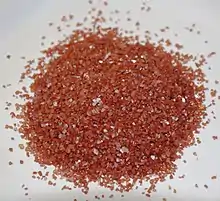 |
A Hawaiian-style sea salt mixed with a red volcanic clay | |
| Asin tibuok | Literally "whole salt" or "unbroken salt." A rare Filipino artisanal sea salt made from filtering seawater through ashes and boiling it with coconut milk. Also known as tultul or dukdok. Used as seasoning by scraping over food.[2][3][4] | ||
| Bahamas Sea Salt | Sea Salt | Sea salt has been produced on Great Inagua Island since the 1930's. The Morton Salt Company bought the facility in 1954.This site, comprising 300,000 acres on Great Inagua Island, produces about a million pounds of salt per year‚ the second largest saline operation in North America. Bahamas sea salt can be found in grocery stores and supermarkets in the United States. [5] | |
| Balinese Sea Salt | Sea Salt | This seawater is poured over a flat area of raked black sand and left to evaporate for several days. The dry salty sand is gathered and transferred into a series of coconut trunk vats. More sea water is then poured over the salty sand — this filtering process can be repeated several times, until the briny liquid reaches its briniest. The brine is poured into long hollow tree trunks and left to evaporate completely for a final time. | |
| Black lava salt |  |
A salt colored with activated charcoal. Hawaiian manufacture among others. | |
| Brine | A saltwater used in the preservation of food | ||
| Cooking salt | 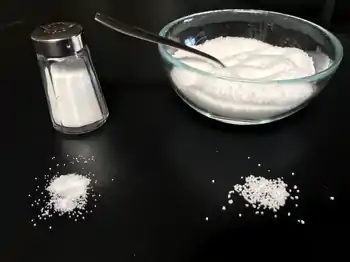 |
A coarse salt that is used in cooking but not at the table. | |
| Croatian Sea Salt | Sea salt | Evaporated from Adriatic sea water collected in salt pans at the town of Nin, Croatia | |
| Curing salt | 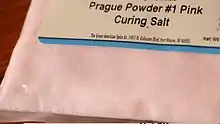 |
A salt containing sodium nitrate, used in the preservation of meats[6] | |
| Cyprus pyramid salt | Sea Salt | Flakes shapes resembling pyramids evaporated from salt pans around the island of Cyprus | |
| Dead Sea salt | Dead Sea salt refers to salt extracted or taken from the Dead Sea | ||
| Egyptian Frost Salt | mined | crystalline salt that takes its name from its texture similar to frost | |
| Einville Salt | Salt from brine | Brine is pumped to the surface of a well from 200 meters below ground and evaporated to produce the salt. Production is by Salines d'Einville, located in Einville-au-Jard, in Lorraine, France. Pétales de sel resemble fleurs de sel. Activity began in 1871, renewed in 1988. [7] Similar to salt produced by the J.Q. Dickinson Salt-Works in the Kanawha Valley in West Virginia and Maras salt from Peru. | |
| Flake salt | A type of salt with flake-shaped crystals | ||
| Fleur de sel |  |
A hand-harvested sea salt, Typically from France | |
| Guerrero Negro | Sea Salt | One of the largest producers of salt in the world, producing evaporated sea salt from the Guerrero Negro, Mexico Salt pans | |
| Halite | 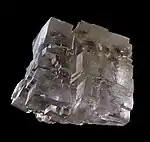 |
Rock | The mineral term for rock salt |
| Himalayan salt |  |
Rock | A rock salt with a pink color, mined in Pakistan. |
| Jukyeom | A Korean salt roasted in bamboo | ||
| Kalahari Salt | From the Kalahari Desert salt pans | ||
| Kanawha Valley Salt | Salt from brine | Produced by the J. Q. Dickenson Salt Works in Malden, West Virginia.[8] Brine is pumped to the surface from 300 feet below ground and evaporated to produce the salt. Similar to Einville salt and salt from Maras in Peru. | |
| Kala Namak (Black Salt) | .jpg.webp) |
Rock | Kala namak is a kiln-fired rock salt used in South Asia with a sulphurous, pungent-smell.
It is also known as "Himalayan black salt" |
| Khoisan Salt Pearls | South African Sea Salt formed by wind action across a salt pan | ||
| Kitchen salt |  |
A coarse salt that is used in cooking but not at the table | |
| Kosher salt | 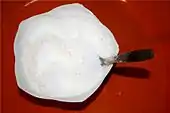 |
A large-grained, non-iodised salt | |
| Lake Grassmere Salt | Sea Salt | Seawater, from the Pacific Ocean, is pumped into Lake Grassmere, New Zealand and evaporated. | |
| Ilocano Asin | Sea Salt | Evaporated in salt ponds and hand harvested at Pangasinan province in the Philippines. Ilocano Asin is coarse, moist, white, and salty. | |
| Maldon sea salt | Sea salt flakes harvested in the River Blackwater, Essex, UK | ||
| Maras Salt | Salt ponds are more commonly found on coastal plains, filled with seawater from the incoming tide. The ones in Peru are at an altitude of 3,000 metres. It’s a long way to the ocean, but it wasn’t always so; this impressive mountain range was once part the sea floor.
The movement of tectonic plates pushed the seabed up to form the Andes. The sea salt was locked into the rocks and filters out through the Qoripujio spring, which is then routed to roughly 5,000 evap ponds staggered down the valley in terraces. | ||
| Mongolian Lake Salt | Evaporated from saline lakes in inner Mongolia | ||
| Murray River Salt Flakes | Salt from the Australian Murray River basin. Peach-coloured flake salt. The salt contains calcium and magnesium and has a relatively mild taste. | ||
| Namibian Salt Pearls | Sea salt | Formed naturally by the Namibian Berg Wind as they tumble on the water's edge | |
| Netarts Bay, Oregon, Salt | Sea salt | Pure flake sea salt is harvested from Netarts Bay on the Oregon Coast by Jacobsen Salt Company, founded in 2011. [9] | |
| Persian Blue Salt | Rock | Extracted from a salt mine in the northern province of Semnan in Iran. The intriguing blue colour occurs during the forming of the salt’s crystalline structure, as intense pressure is exerted on the salt deposits. The individual crystals fracture the light in an unusual way and the resulting blue (which is caused by an optical illusion), becomes visible. | |
| Pickling salt | A fine-grained, non-iodised salt used for pickling | ||
| Sal de Tavira | A Portuguese sea salt extracted from salt pans on the Atlantic coast (PDO)[10] | ||
| Sale Marino di Trapani |  |
An Italian sea salt extracted from the salt pans of Trapani, Paceco and Marsala (PGI)[11] | |
| Sea salt |  |
Generic term for salt derived from evaporation or reduction of sea water. Mineral content varies with locale and drying process. | |
| Sel gris | A French-style sea salt. It tends to be grey in color and somewhat moist. | ||
| Sel de Guérande | A French sea salt from the salt marshes of the Guérande Peninsula (PGI)[12] | ||
| Smoked salt | 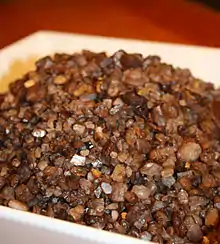 |
Flavoured or seasoned |
Flavor altered by type of wood used or length of smoke process |
| Sugpo Asin | Sea Salt | Sugpo Asin are hollow crystals that are ever-so-slightly-pink due to the shrimp that live in the salt beds from which this particular salt is harvested | |
| Utah Salt | Rock | From an underground salt deposit in Central Utah. The deposit was left there by an ancient sea that covered much of North America millions of years ago | |
| Yellowstone salt | Rock | From a subterranean deposit brought to the surface by spring water and evaporated |
References
- "'Anglesey Sea Salt'/'Halen Môn'". OJEU. Retrieved 2014-03-22.
- "Asin Tibuok Unbroken Salt". Slow Food Foundation for Biodiversity. Retrieved 18 December 2018.
- |website=xroads |accessdate=18 December 2018}}
- "'Asin tibuok' at Kitchen Elf". The Philippine Star. 14 December 2017. Retrieved 18 December 2018.
- https://www.bahamas.com/plan-your-trip/things-to-do/morton-salt-factory
- Bitterman, M. (2010). "Salt Reference Guide". Salted: A Manifesto on the World's Most Essential Mineral, with Recipes. Random House. p. 187. ISBN 1580082629. Retrieved 2013-08-16.
- http://www.saline-einville.com/
- https://www.jqdsalt.com
- https://jacobsensalt.com/collections/pure-sea-salt
- "Sal de Tavira'/'Flor de Sal de Tavira'". OJEU. Retrieved 2014-03-22.
- "'Sale Marino di Trapani'". OJEU. Retrieved 2014-03-22.
- "'Sel de Guérande/Fleur de sel de Guérande'". OJEU. Retrieved 2014-03-22.
This article is issued from Wikipedia. The text is licensed under Creative Commons - Attribution - Sharealike. Additional terms may apply for the media files.